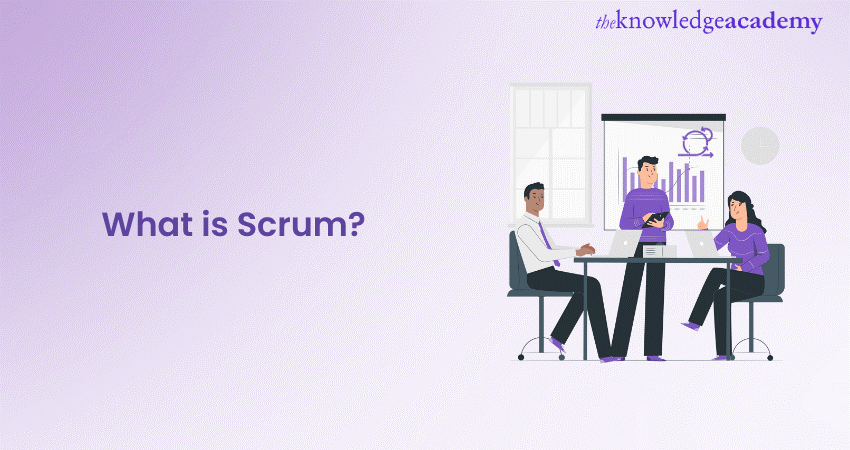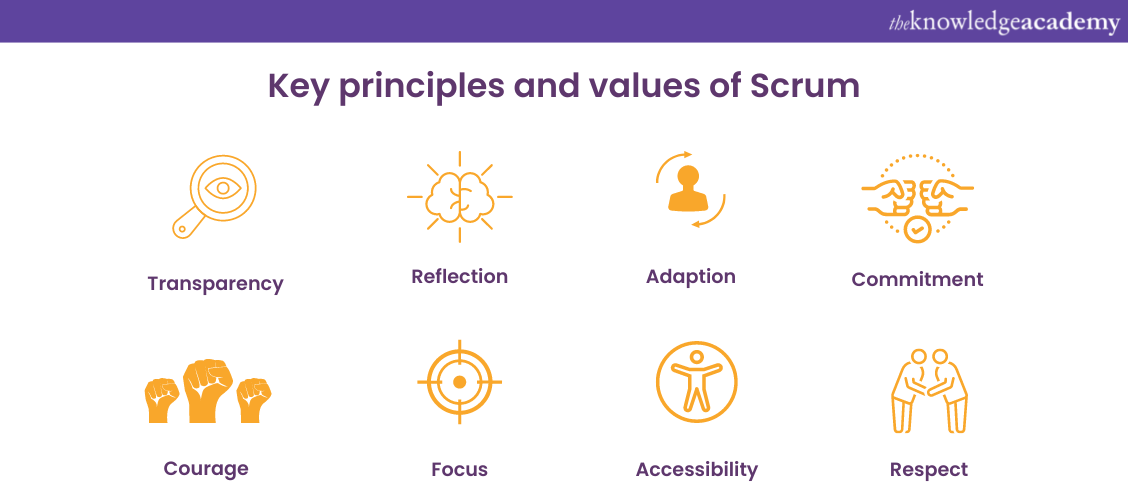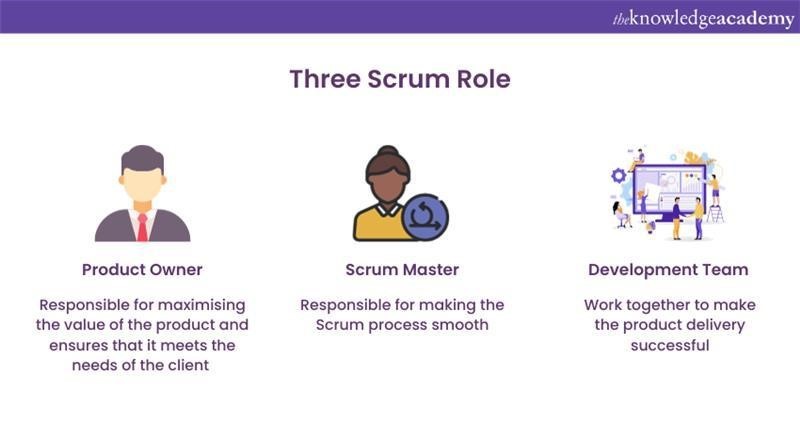We may not have the course you’re looking for. If you enquire or give us a call on +44 1344 203999 and speak to our training experts, we may still be able to help with your training requirements.
Training Outcomes Within Your Budget!
We ensure quality, budget-alignment, and timely delivery by our expert instructors.

If you are new to the world of Software Development, you may have heard the term "Scrum" many times. But do you know What is Scrum? In simple terms, it is a framework that helps teams work together to deliver a high-quality product in an Agile environment.
It is a sought-after approach to Software Development that focuses on teamwork, communication, and frequent repetitions.
The “Impact of Agile Quantified” report from Broadcom Software indicates that teams utilising Scrum can achieve a 250% improvement in quality over non-Scrum teams.
This underscores the significance of Scrum in Project Management. In this blog, we’ll explore What is Scrum, its stages, methodologies, frameworks and much more. Read now!
Table of Content
1) What is Scrum?
2) What is Scrum Methodology?
3) How does Scrum work?
4) What is Scrum Framework?
5) What are Scrum Artifacts?
6) What are Scrum Roles?
7) What are Scrum Events?
8) Advantages and Disadvantages of Scrum
9) Best Scrum Tools
10) Relationship between Agile and Scrum
11) Difference between Scrum and Kanban
12) Conclusion
What is Scrum?
Scrum is a framework used for managing the development of products and moving towards a common goal. It follows a way that empowers teams to develop a model about how something works, experiment with it, look upon the results, and make necessary adjustments. This approach works productively only when the framework is implemented correctly. Additionally, Scrum is designed so that teams can integrate practices from other frameworks that suit their specific context.
What is Scrum methodology
Scrum principles emphasise three key aspects to success in a project: transparency, reflection, and adaptation. Here's a brief look at key Scrum principles:
a) Open communication channels between cross-functional team members and Project Owners ensure transparency, enabling everyone to be aware of the challenges that others might be experiencing. This helps prevent information bottlenecks and miscommunication that could slow down the project.
b) Reflection is built into the Framework with regular review meetings that allow team members to assess their progress, and Project Managers can use the insights gained from these meetings for estimations and future planning. This helps projects to run smoothly on time and within the budget.
c) Adaptation is also essential as team members can update the tasks on priority based on changing customer requirements. It helps them decide which tasks to complete first and which to do in the future.
Scrum Values
In 2016, the Scrum Guide was enhanced with five core values that steer the conduct and collaboration of Scrum Teams, which are vital for their triumph.
a) Commitment: Members of Scrum Teams are pivotal to the team’s victory. They must pledge to achievable tasks and maintain regular updates on their progress.
b) Courage: Scrum Teams must possess the bravery to challenge impediments and the norm. They should feel empowered to innovate and be candid about any obstacles or delays.
c) Focus: Sprints are the essence of Scrum Teams’ workflow. They provide a dedicated timeframe to accomplish specific tasks, thereby ensuring concentrated efforts toward task completion.
d) Openness: Daily stand-ups promote transparency, enabling team members to discuss ongoing tasks and potential hindrances openly. This practice not only tracks progress but also fortifies team unity.
e) Respect: The power of an Agile team is amplified through mutual respect and acknowledgement of each member’s contribution to the sprint’s workload, fostering a culture of appreciation and esteem.

Elevate your Project Management skills with our Managing Agile Projects with Scrum Course - register now and lead your teams to success!
How does Scrum work?
Scrum methodology merges the principles of Agile philosophy with the Scrum Framework. In Agile, development occurs gradually through small repetition. Meanwhile, Scrum is an Agile methodology that breaks projects into smaller chunks known as Scrum Sprints. Agile Scrum methodology is ideal for businesses looking to complete specific projects in time.
This Project Management system depends upon gradual development, with each iteration consisting of Sprints lasting two to four weeks. The objective of each Sprint is to build the most critical features and create a potentially deliverable product. Subsequent Sprints add more features and adjust based on stakeholder and customer feedback.
Unlike other Project Management methods that focus on completing a product from start to finish, Scrum Methodology emphasises delivering several repetitions of a product to provide the highest value to the business in the shortest time possible. It also offers numerous benefits, including faster product development, since each Sprint has a defined set of goals. Regular goal setting and planning help the Scrum team concentrate on the current Sprint's objectives, increasing productivity.
What is the Scrum Framework?
The Scrum Framework provides a structured and well-defined approach for the teams working on Scrum projects. This framework enables teams to collaborate and deliver high quality products and services based on the objectives of the project. With a proper framework, teams can ensure transparency and adaptation of useful methodologies at various levels of the organisation.
What are Scrum Artifacts?
To manage projects and solve problems, Scrum teams use the tools known as Scrum Artifacts. It helps inform stakeholders and team members about tasks. The primary artefacts include Sprint backlog, Product Backlog, increment, and burn down.
The dynamic list of features, enhancements, requirements, and fixes required for project success is known as the Product Backlog. The team's ongoing task list is continuously reprioritised and reviewed to align with changing market conditions. The Product Owner is responsible for updating and maintaining the list to eliminate irrelevant items, including new customer requests.
The Sprint Backlog represents a table of tasks that the development team must accomplish within the current Sprint duration. The team selects the items from the Product Backlog it will focus on at the start of each Sprint. The Sprint Backlog can adjust and adapt to changing circumstances as the Sprint progresses.
The increment is an essential artefacts in Scrum that represents the result of all the completed Product Backlog items at the end of each Sprint. Along with completed features and stories, it is a potentially shippable product that provides value to the stakeholders. It is also necessary to give the Product Owner and stakeholders feedback on the Product Development progress.
In Scrum, burn-down charts are used to track the work progress in the given time frame. Usually, it is a graphical representation of the Product Backlog. It is represented through X and Y axes, where the X axis represents time, and the Y axis represents work. In the case of the Product Backlog, the graph represents a downward trend.
What are Scrum roles?
There are three different roles in Scrum. It ensures that the team is successful in delivering high-quality products. The primary Scrum Roles are - Product Owner, Scrum Master, and Development Team. Let's learn about them in detail:

Product Owner
The Product Owner's responsibility is to maximise the value of the product and ensure that it meets the needs of the stakeholders and customers. They are the ones who decide what functionality and features need to be get included in the Product Backlog and prioritise the items based on business value. They are the connecting authority between the business needs and the understanding of the teams.
Product Owners work closely with the Development Team to ensure they understand the requirements and are working on the highest priority items. They Product Owner acts as the single point of contact for the Development Team and are responsible for answering their questions about the Product Backlog. It is necessary to have one person as a Product Owner to avoid mixed guidance from multiple people.
Scrum Master
The Scrum Master is responsible for making the Scrum process smooth and ensuring the team follows the Scrum Framework. Rather than being a manager or team leader, they act as a helper or assistant who helps the team work together and achieve their goals.
The Scrum Master Roles and Responsibilities entail helping the team understand and follow the Scrum processes and removing any difficulties blocking their progress. This ensures that the team is delivering value to the customers. They also solve the team's challenges by communicating with external groups. Additionally, they are responsible for digital transformation and help adopt it by training the team.
Development Team
The Development Team consists of Developers, Testers, Designers, and other specialists who work together to make the product delivery successful. Usually, this Team is smaller in number, comprising five to seven people.
The Development Team divides the plans into pieces and estimates the effort required to complete every piece. In addition to the estimation, they take valuable feedback over time, ensuring that they meet their Sprint commitments.
Understand Scrum's principles, definitions, and terminology by signing up for our Scrum Product Owner Certification Course now.
What are Scrum Events?
Scrum Events are opportunities that help teams collaborate, streamline their efforts and adapt to new methodologies based on requirements. Some of the most crucial Scrum Events are as follows:
Daily Scrum
Daily Scrum is a short meeting held on a daily basis that inspects the progress of Sprint for the coming day. The team discusses the objectives and hurdles and other relevant aspects which will help them deliver the objective on time.
Sprint
The Sprint event is completed in 2-4 weeks of time. During this process the teams work on achieving the objectives and goals to make the product successful.
Sprint Planning
A Sprint Planning event is a meeting which is conducted at the beginning of each Sprint. This meeting outlines the overall process of Sprint and plans the work that needs to be done by each team or individual.
Sprint Review
In the Sprint Review event, stakeholders are invited to provide valuable feedback on the developed product. This is an important event that addresses the potential drawbacks or improvements that can make the product better.
Sprint Retrospective
After the Sprint review, the Scrum Team holds a meeting focusing on the work processes and ways to improve the productivity of the teams for upcoming Sprints.
Advantages and Disadvantages of Scrum
Scrum is a popular Agile Project Management Framework that’s particularly beneficial in Software Development and other industries requiring rapid iteration and flexibility. Here are some key Advantages and disadvantages of Scrum:
Scrum Advantages
Here is the list of advantages of using Scrum:
a) Scrum is highly adaptable to changing project requirements, making it ideal for environments where needs evolve rapidly.
b) The iterative nature of Scrum encourages creative solutions and continuous improvement.
c) Scrum can reduce the time to deliver products or features by focusing on incremental development.
d) By identifying issues early, Scrum can help reduce the overall cost of development.
e) Regular meetings and reviews increase visibility into the project’s progress for all stakeholders.
Scrum Disadvantages
Here is the list of disadvantages of using Scrum:
a) Proper implementation of Scrum requires a well-trained team, which can be a significant investment in time and resources.
b) Scrum can be challenging to scale for larger projects or organisations.
c) The success of Scrum heavily relies on the commitment and collaboration of the entire team.
Best Scrum Tools
Selecting the right Scrum tool can significantly enhance your team’s productivity and Project Management efficiency. Here are some of the top Scrum Tools available in the market today:
a) monday.com: Ideal for highly collaborative teams, offering features like drag-and-drop scheduling and progress tracking.
b) Jira Software: A favourite among Agile teams, particularly for backlog management.
c) ClickUp: Known for its versatility, it’s suitable for managing sprints and offers a feature-rich Free Forever Plan.
d) Zoho Sprints: Great for real-time collaboration with a focus on Scrum boards.
e) Miro: Offers built-in video conferencing and is excellent for remote teams.
Relationship between Agile and Scrum
Agile and Scrum are closely related methodologies. However, there are some crucial differences between both. Agile is a philosophy that promotes teamwork, collaboration, customer focus and adaptability in an organisation. Meanwhile, Scrum is a method to adapt Agile frameworks and its core principles to manage projects.
The Scrum processes include a step-by-step guide to achieve project objectives. On the other hand, Agile is a process focusing on exploring how to approach projects and adjusting the plans based on the project's requirements in regular meetings.
Agile and Scrum methodologies together can bring the best out of organisations. While Agile methods helps the organisation to foster an objective and productive mindset and adaptation. Scrum methodologies help achieve objectives with practical implementation and time-bound work processes.
Difference between Scrum and Kanban
Scrum and Kanban are both Agile methodologies used in Project Management, but they differ in their approach and execution. Here are the points of comparison highlighted for Kanban vs. Scrum:
|
Key differentiators |
Scrum |
Kanban |
|
Roles |
Defined roles such as Product Owner, Scrum Master, and Development Team. |
No predefined roles; the team may have a Kanban Lead or Service Delivery Manager, but it’s not mandatory. |
|
Iterations |
Work is divided into sprints, which are fixed-length iterations, typically 2-4 weeks long. |
No set iterations. Work is continuously pulled as capacity permits. |
|
Ceremonies |
InCludes Sprint Planning, Daily Stand-ups, Sprint Reviews, and Retrospectives. |
Less prescriptive; may include regular stand-ups and other meetings as needed. |
|
Artifacts |
Product backlog, Sprint backlog, and increment of potentially shippable product. |
Kanban board with cards representing tasks. |
Here is list of differences between Scrum and Kanban:
a) Flexibility in planning: Kanban allows for more flexibility as it’s a continuous flow, whereas Scrum has fixed-length Sprints.
b) Roles and responsibilities: Scrum has specific roles that are not present in Kanban.
c) Board structure: Scrum boards are reset after each Sprint, while Kanban boards are continuous.
d) Work In Progress (WIP): Kanban limits WIP to ensure flow efficiency; Scrum focuses on completing a set amount of work each sprint.
Conclusion
Scrum is a flexible approach to Project Management that highlights communication, teamwork, and continuous improvement. It can be a highly effective method for delivering high-quality results in a timely and efficient manner. Scrum offers a framework for building better products and empowering teams to achieve their full potential. By understanding What is Scrum and applying it to your organisation, you can enable teams to collaborate effectively and respond quickly to changes in requirements or priorities.
Become a Scrum Developer by understanding the technicalities of Scrum Framework by getting our Scrum Developer Training.
Frequently Asked Questions

The five principles of Scrum are Commitment, Focus, Openness, Respect, and Courage. These values guide teams in collaborative work, ensuring transparency, inspection, and adaptation within the Scrum Framework.

Agile is a methodology emphasising continuous iteration in development and testing, while Scrum is a specific Agile process focusing on delivering business value swiftly through rapid and repeated inspection of working software. Scrum is known for its flexibility and adaptability to changing requirements.

The Knowledge Academy takes global learning to new heights, offering over 30,000 online courses across 490+ locations in 220 countries. This expansive reach ensures accessibility and convenience for learners worldwide.
Alongside our diverse Online Course Catalogue, encompassing 17 major categories, we go the extra mile by providing a plethora of free educational Online Resources like News updates, Blogs, videos, webinars, and interview questions. Tailoring learning experiences further, professionals can maximise value with customisable Course Bundles of TKA.

The Knowledge Academy’s Knowledge Pass, a prepaid voucher, adds another layer of flexibility, allowing course bookings over a 12-month period. Join us on a journey where education knows no bounds.

The Knowledge Academy offers various Scrum Courses, including Scrum Certification, Product Owner and Scrum Developer Courses. These courses cater to different skill levels, providing comprehensive insights into Scrum Tools for Project Management.
Our Project Management Blogs cover a range of topics related to Scrum, offering valuable resources, best practices, and industry insights. Whether you are a beginner or looking to advance your Project Management skills, The Knowledge Academy's diverse courses and informative blogs have you covered.
Upcoming Project Management Resources Batches & Dates
Date
 Scrum Master Certification
Scrum Master Certification
Thu 6th Jun 2024
Thu 4th Jul 2024
Thu 1st Aug 2024
Thu 5th Sep 2024
Thu 3rd Oct 2024
Thu 7th Nov 2024
Thu 5th Dec 2024









 Top Rated Course
Top Rated Course



 If you wish to make any changes to your course, please
If you wish to make any changes to your course, please


